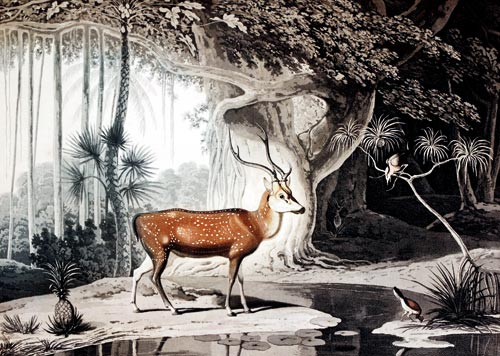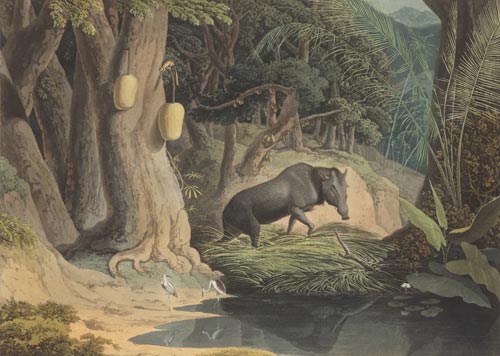Capturing facets of Ceylon
The National Museum in Colombo possesses nine small pencil sketches and wash drawings and an oil painting attributed to Samuel Daniell, many drawn from the artist’s visit to the north, the Jaffna district in particular. Widely regarded as the most accomplished British artist to visit Sri Lanka in the 19th century, Samuel Daniell died in Colombo before he turned 36, struck down by malarial fever and was buried in an unmarked grave at the Pettah Burial Ground.
He came from a family of artists. For almost two centuries, the Daniells – Thomas (1749-1840) and William (1769-1837) – both Royal Academicians were well known for their brilliant aquatints, the outcome of their extended exploratory tours of India between 1785 and 1794. Of Samuel Daniell, considered by many as the most talented of this family of painters very little is known in comparison to his uncle Thomas and brother William.
Samuel Daniell was born in Chertsey, England in 1775. His uncle sailed to China and India accompanied by William who was barely 15 and five years older than Samuel. Their father had died in 1779 leaving the boys in the care of their uncle Thomas.
While his brother was away in India, Samuel later evinced an interest in art while enrolling as a student at the East India College at Hertford where he came under the influence of Thomas Medland, an accomplished landscape painter and master of Persian calligraphy.

Into the wilds: Two of Samuel Daniell's animal portraits
Somewhat of a prodigy, at 16, one of his works was accepted to be exhibited at the prestigious Society of Arts. The very next year, the Royal Academy accepted his painting The View of Chertsey to be displayed at their annual exhibition. The Academy was to exhibit more of his works but Samuel was bent on carving a future for himself overseas.
His abiding interest in natural history documentation led Samuel to visit the Cape of Good Hope during the early years of British occupation. He sailed on the H.M. Lancaster in 1799 and arrived at the Cape on December 9 that year. He was attached to the staff of the Governor but did not stay long at this post.
He was then appointed Secretary and Draughtsman to the mission to Botswana in October 1801, a journey that covered several hundred miles and resulted in a fine collection of natural history drawings which depicted the fauna and flora of the country, little recorded before.
Samuel returned to England and in 1804, African Scenery and Animals drawn and engraved by Samuel Daniell, was published in two volumes each having 15 plates. It was priced at 21 pounds. Meanwhile other engravings of his appeared in several publications.
By April 1805, Samuel decided to explore another exciting part of the tropics. He sailed from Portsmouth on the H.M.S. Greyhound to Ceylon. The ship docked in Galle on August 14. In July 1805, Sir Thomas Maitland who was to be his future patron and friend had taken office. Eight months later, the Ceylon Government Gazette announced that Samuel Daniell had been appointed Assistant Secretary to the Board of Revenue and Commerce. In addition, he was to hold the post of Ranger of the Woods and Forests.
 This enabled him to satisfy his craving for exotic subjects coupled with his desire for exploration. Samuel produced 12 brilliant aquatints based on his watercolour sketches portraying rare and colourful species of animals and plants never executed by an artist in the island before.
This enabled him to satisfy his craving for exotic subjects coupled with his desire for exploration. Samuel produced 12 brilliant aquatints based on his watercolour sketches portraying rare and colourful species of animals and plants never executed by an artist in the island before.
On January 15, 1808, ‘A picturesque illustration of the scenery, animals and natives of the Island of Ceylon’ in 12 plates engraved after the drawings by Samuel Daniell, was published.
Two interesting episodes of the artist’s life in this country are referred to by J.W. Bennett who arrived five years after Samuel’s death in the book ‘Ceylon and its Capabilities’(1843). Though there might be an element of exaggeration it confirms the fact that the Governor and the artist were close friends. The latter was a frequent visitor to Maitland’s residence in Mount Lavinia whose gardens Samuel used to visit; he used some of this landscape as a backdrop to his aquatints.
The first English woman writer and visitor to the island has this to add. A proficient author, amateur scientist, artist and popular writer of travel and children’s books, Maria Graham, describes meeting the artist at an elephant kraal near Negombo. These incidents during her visit to the island in March 1810 are recounted in her book Journal of a Residence in India 1812.
We left Colombo early on the sixth and after break fasting in a pretty bungalow on the way, we reached Negombo to dinner where we werejoined by the collector of the district, a learned ingenious man and Mr. Daniell the painter whose printed views you must have seen.
We slept in the rest house; and next morning early we set off for the elephant kraal or trap which is sixteen miles from Negombo and within half a mile of the Candian frontier.
However, we left Mr. Daniell at the kraal where he intended to stay some time in search of subject for his pencil. To defend himself from the bad effects of his sylvan life, he smokes and lights great fires within and without his tent.
The drawings of elephant trappings sketched at this site were sent to Samuel’s brother William after his death. A painting titled A Panoramic view of the Capture and Taming of Wild Elephants on the Island of Ceylon was exhibited at the Society of Painters in Watercolours in Pall Mall and in 1835 an engraving of the same scene was published measuring 18x 122 cm and was available to the public at one shilling
In 1810 a few weeks after his visit to the elephant capture, Samuel toured the west coast and visited Galle, Matara, Dondra, Akuressa and the forests around these areas in his capacity as Ranger.
In October 1811, he was still busy overseeing the felling of trees for Governmental use, but this short stay in the forest teeming with malarial mosquitos proved fatal to his health. On December 18, 1811, the Ceylon Government Gazette carried a small notice- Died at Colombo early yesterday morning Samuel Daniell. But in England the prestigious The Gentlemen’s Magazine of 1812 October gave him more prominence:
“In December last died in Ceylon after an illness of a few days Mr. Samuel Daniell. Early in life Mr Daniell embarked for the Cape of Good Hope, where after some stay he passed into the interior of Africa collecting much valuable information his way and making drawings of all the objects worthy of attention even while continually assailed by hardships and exposed to danger in various shapes. Here in Ceylon during a residence of nearly six years he found an abundant means of increasing his graphic stores.”
On May 9, 1812, his personal belongings consisting of mainly of his art materials were put up for sale at the auction rooms of Messers Loughlins in the Fort, Colombo. A list of items published in a notice of the Government Gazette of May 6 provides an interesting insight into the equipment and materials used by a European artist of the early 19th century: Varley’s patent Graphic Telescope in a mahogany case, a few copper plate prints, camel hair brushes, pencil, black leads, cakes of water colours, a box of chalks for drawing, drawing papers etc, etc.
His possessions which included a set of two volumes African Scenery & Animals were put up for sale by the same auctioneers on February 27, 1813. The majority of his drawings and sketches including his sketch books were sent to William Daniell in England in 1813 or 1814.
Although unrecognized during his lifetime the editors of the prestigious Dictionary of National Biography thought it fit to include Samuel Daniell, among the handful of personalities from Britain that resided in Sri Lanka.
Searching for an ideal partner? Find your soul mate on Hitad.lk, Sri Lanka's favourite marriage proposals page. With Hitad.lk matrimonial advertisements you have access to thousands of ads from potential suitors who are looking for someone just like you.


